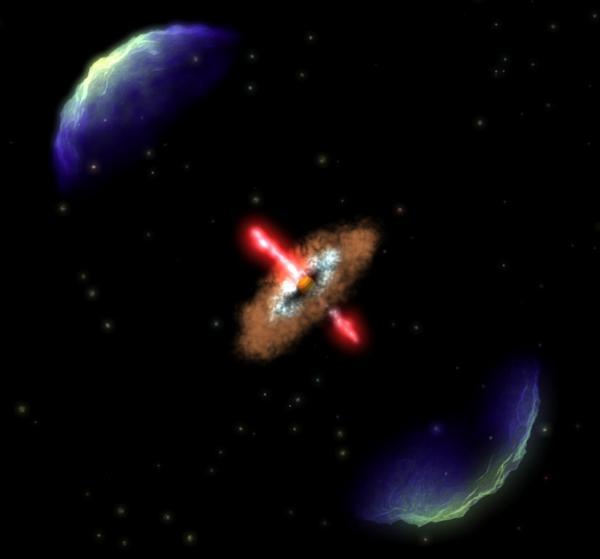How brown stars form
Astronomers have discovered evidence that brown stars have the same process of formation as normal stars.
Using Smithsonian's Submillimeter Array (SMA), astronomers discovered that carbon dioxide molecules are released from an object called ISO-Oph 102. Such molecular release is often seen in young stars. However, this object has 60 times the mass of Jupiter, meaning that it is too small for a star. Astronomers put it in the brown star category.
Brown stars belong to the list between the planet and the star, often with a mass of 15 to 75 times Jupiter (Minimum mass for a star to withstand 75 fossils of Jupiter). Therefore, brown stars are also called incomplete stars. However, it is unclear whether they form like stars, from gas clouds, or they form like planets, accumulating rocky matter until they are large enough.
A star forms when a gas cloud collapses itself by gravity, becoming denser and hotter until a nuclear fusion reaction occurs. If the cloud is spinning, the rotation will be faster as the cloud shrinks, similar to the skier who slips and collapses.To gather weight, a young star must generate angular momentum by pushing matter in opposite directions.
 Illustration of ISO-Oph brown star 102. Observation by SMA shows that it forms like a regular star, by accumulating matter from the surrounding accretion disk (orange). Brown stars emit a momentum by pushing matter in opposite directions (red). The green pulse arc is where these rays interact with the interstellar space. (Photo: ASIAA) .
Illustration of ISO-Oph brown star 102. Observation by SMA shows that it forms like a regular star, by accumulating matter from the surrounding accretion disk (orange). Brown stars emit a momentum by pushing matter in opposite directions (red). The green pulse arc is where these rays interact with the interstellar space. (Photo: ASIAA) .
A brown star has a smaller weight than the star, so the gravity needed to shrink itself is smaller. So astronomers have always argued about the formation of brown stars. Previous observations show that they form similar to stars. The detection of ISO-Oph 102's dipole molecule release is the first clear evidence of brown star formation.
Ngoc Phan-Bao, the main author of the study of the Academia Sinica Astronomical Academy, said: 'We think such molecular release is difficult to detect with current technology and must wait for the device New system like ALMA [Atacama Large Millimeter Array]. This discovery is a big surprise. The ability to search for molecular release lines reveals the extraordinary ability of SMA '.
However, this element contains about 1,000 times the mass of the normal star. The release rate is also about 100 times smaller. The molecular release of ISO-Oph 102 is the miniature scale of the molecular release process of young stars.
Paul Ho, an astronomer at Tr Center for Harvard-Smithsonian astrophysics and director of ASIAA, said: 'These findings suggest that brown and later stars are not so different. They have the same mechanism of formation. An object that becomes a brown star or an ordinary star obviously depends on the amount of material available '.
The article about ISO-Oph 102 will be published in Astrophysical Journal Letters on December 20.
- Brown stars don't go with normal stars
- Brown stars are the third cosmic object after stars and planets
- Stars form at record speeds in galaxies
- Amazingly explore the mysterious nature of brown dwarfs
- Beautiful photos: Admire the most intense galaxy to form stars
- Not just big stars, ancient dwarfs also have dust disk rings
- Light from the first stars
- 9 interesting things about stars
- How are stars created?
- Further evidence of brown dwarf origin was found
- Detecting a pair of stars
- Brown bear in the fishing season
 Van Allen's belt and evidence that the Apollo 11 mission to the Moon was myth
Van Allen's belt and evidence that the Apollo 11 mission to the Moon was myth The levels of civilization in the universe (Kardashev scale)
The levels of civilization in the universe (Kardashev scale) Today Mars, the sun and the Earth are aligned
Today Mars, the sun and the Earth are aligned The Amazon owner announced a secret plan to build a space base for thousands of people
The Amazon owner announced a secret plan to build a space base for thousands of people A shooting star, about to explode in the sky of Earth?
A shooting star, about to explode in the sky of Earth?  Image of a new star spewing gas loudly across the Milky Way galaxy
Image of a new star spewing gas loudly across the Milky Way galaxy  The 'deadly' truth about strange radio signals transmitted to Earth
The 'deadly' truth about strange radio signals transmitted to Earth  Scientists Stunned to Discover Star With Supersonic Tsunamis Three Times Higher Than the Sun
Scientists Stunned to Discover Star With Supersonic Tsunamis Three Times Higher Than the Sun  Death 11.5 Billion Years Ago Bombs NASA: A Chilling Prediction for Us
Death 11.5 Billion Years Ago Bombs NASA: A Chilling Prediction for Us  In 2024, the cosmic monster in the 13th century ancient text will return.
In 2024, the cosmic monster in the 13th century ancient text will return. 